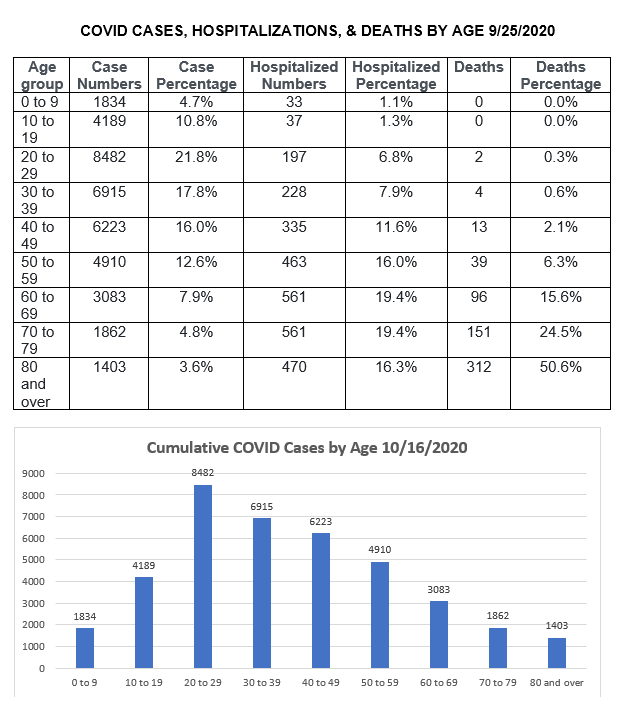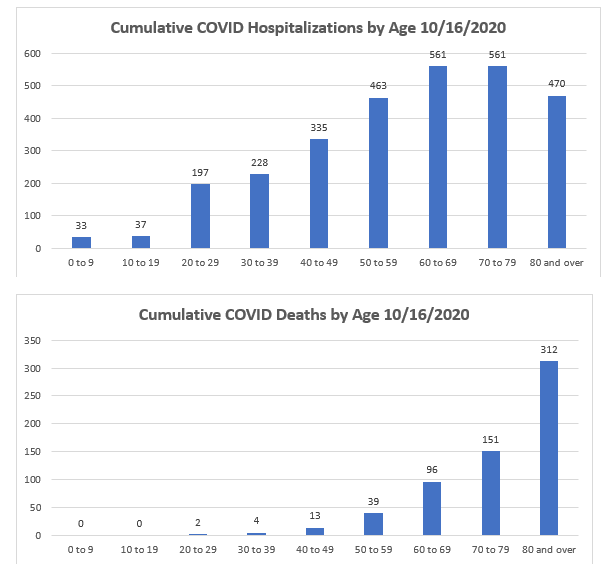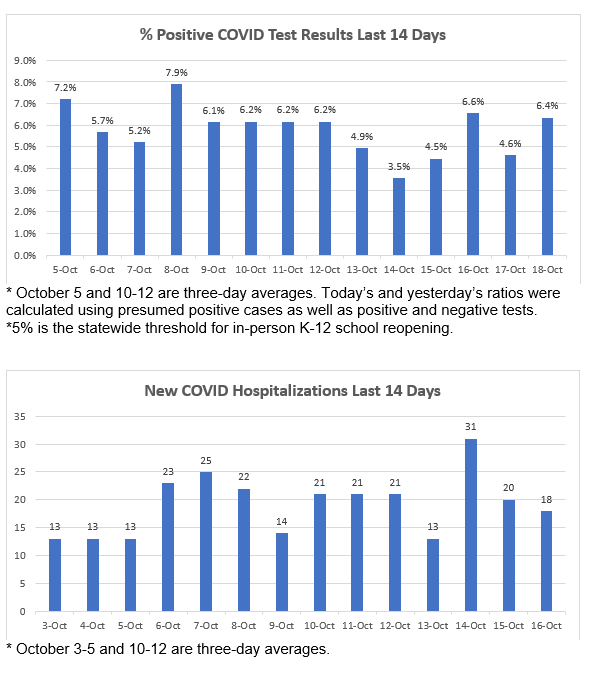|
October 18, 2020
I hope that you and your loved ones are doing well, staying healthy, and looking out for your neighbors and friends in these difficult times.
Since it’s Sunday, you’ll find only partial reporting on some of the metrics tracking coronavirus in Oregon. Instead of giving us the positive test results alone, over the weekend OHA combines those numbers with the relatively small number of those who are presumed to be positive based on their symptoms and close proximity to someone who has tested positive, but whose test results have not yet come back. But it still gives us a good idea of what’s going on.
The case numbers are down today, but that’s likely due to lower test results being reported today. As a result, the positivity rate for the state has again risen.
We also don’t get hospitalization numbers over the weekend, so we won’t know what the rate of increase is till Monday. Deaths are reported, however. Fortunately, OHA reports that no additional Oregonians have died from COVID.
As I’ve been doing on Sundays, I’m also including updated information about how COVID is affecting people of different ages. We see the same trends as in past weeks: COVID cases are most prevalent in younger people, but they tend to be less likely to be hospitalized or die from the disease. When it is passed on to older people, however, it becomes much more dangerous. Increasingly, those dying from the disease are people in their 80s and 90s who are exposed.
This newsletter also includes my reporting on the latest update to the COVID modeling that OHA uses. As you’ll see, I believe that we are at another crossroads with respect to the future of COVID transmission in the state. Relative to other states, we are in a fairly good place right now (see the state-by-state animations that I linked to in yesterday’s newsletter). We could be even better if we could just get back to where we were late in the summer. But that was when it was easier to hold most activities outdoors, before universities and some schools started to reopen for in-person contact, earlier on the road to “COVID fatigue.” It will take a real effort, real focus, to reverse the current trends. If we continue on our current trajectory, we will likely find ourselves more like those other states that are seeing significant increases in cases, hospitalizations, and deaths from this disease.
On the wildfire front, I have nothing to add to yesterday’s report. Everything appears to be very stable for now.
Please let me know if you have any questions about anything in this newsletter.
TODAY’S CORONAVIRUS AND CORONAVIRUS RESPONSE UPDATE
-
Positive Cases: OHA reports that 220 additional Oregonians have tested positive or are presumed positive (see below for definition) for COVID. OHA does not report positive test results alone over the weekend. I’ll be able to readjust the numbers on Monday to remove the presumed positives. The cumulative total for those testing positive and presumed positive since the beginning of the pandemic is 39,532.
-
Total Tests: The number of reported tests has increased by 3,461. Today’s increase in total results also includes presumed positives in the total results, so may be a little high. I’ll readjust the numbers on Monday. The cumulative total is now 785,104.
-
Ratio: The percentage of positive test results for today is 6.4%. The national ratio today is 4.8%.
-
Deaths: I’m happy to report 0 additional deaths due to the coronavirus today. The total number of COVID deaths in Oregon thus remains at 620.
-
Hospitalized: OHA does not report on hospitalizations over the weekend. The cumulative number of those who have been hospitalized with COVID thus remains at 2,886.
-
Presumptive Cases: OHA is including “presumptive COVID-19 cases” in its daily reports, consistent with recently amended guidance from the Centers for Disease Control and Prevention. A presumptive case is someone who does not yet have a positive PCR test but is showing symptoms and has had close contact with a confirmed case. If they later test positive by PCR, those will be recategorized as confirmed cases.
-
Other Hospital Information: OHA DOES NOT REPORT hospitalization information over the weekend, so the numbers below are the same as Friday’s.
- Patients Currently with COVID-19 Symptoms (who may or may not have received a positive test result yet): 190 (9 fewer than yesterday). Of those, 149 have already received a positive test back.
- Available ICU Beds: 161 (2 fewer than yesterday)
- Other Available Beds: 664 (55 more than yesterday).
- ICU Patients w COVID-19 Symptoms: 44 (5 fewer than yesterday).
- COVID-19 Patients Currently on Ventilators: 15 (1 fewer than yesterday).
- Available Ventilators: 786 (8 fewer than yesterday).
-
Dashboards
-
Today’s National Numbers:
-
Additional Brief Updates:
- FEMA has approved the state’s request to make those affected by the wildfires eligible for the Disaster Supplemental Nutrition Assistance Program. DSNAP provides temporary food assistance for households affected by a natural disaster. It will provide at least one month of food-stamps benefits for those in qualifying areas. You can read the information about this from the Department of Human Services.
Disease Model Update: At a Crossroads
OHA has released the latest COVID Model Update from the Institute for Disease Modeling. It’s based on data through October 8, already reflecting a worsening of our disease metrics. Based on those data (which includes both case data and hospitalization data), they have modified their projections to show a higher likelihood of case increases, following the declines that we saw in earlier projections.
The model assumes that only one-fourth of cases are showing up in positive test results or are presumed positive. The remainder are asymptomatic and potentially spreading the disease.
The modelers now believe that the “Re” (Effective Reproduction Number, the number of secondary cases generated by a single case) in Oregon has increased only slightly from 1.13 to 1.15. If the Re level continues, we will continue to see small increases in cases here in Oregon. If we’re able to get that reproduction number back below 1.0, where it was in August and early September, we’ll see the number of new cases begin to decline.
The projection report again provides us with three possible scenarios looking forward, for the next month: “Transmission Continues As-Is,” “Transmission Increases Again,” and “Transmission Returns to August Level.”
Continues As Is:
If we continue as we are now (with an Re of 1.15), by November 5 we’ll see a small increase in the number of detected and undetected cases. The number of newly diagnosed cases will be approximately 570 per day (up from the previous model’s 390), totaling approximately 2,200 if we include undetected cases (up from the previous model’s 1,190). The number of daily new severe cases (i.e., requiring hospitalization) will increase to 40 (up from the previous model’s 25).
Transmission Increases Again:
If we assume that transmission increases by 5 percentage points (with an Re of 1.30) and continues at that level over the next month, the COVID-19 cases will increase more dramatically. The model projects that by November 5:
The number of newly diagnosed cases will be approximately 740 per day (up from the previous model’s 570), and a total of detected and undetected cases of 3,400 (up from the previous model’s 1,700). The number of hospitalizations will rise to 48 per day (up from the previous model’s 32).
Returns to August Level:
This scenario replaces the previous model’s “optimistic” scenario. It assumes that we can get back to where we were in August, which would require a 10% reduction in our current rate of transmission, getting us back to an Re of 0.88. If we can do that, the model predicts that by November 5 new case numbers will again be in decline:
The daily rate of newly detected case will return to approximately 290 per day, and the total number of detected and undetected cases will be 800. Hospitalization rates will be approximately 24 per day.
Needless to say, we’d love to see this final scenario come to fruition. That will likely be a real challenge, though. Those August numbers were prior to any schools or universities going back into session, and prior to the return of fall rains and lower temperatures. On the other hand, we’re starting to have increasing ability to deploy testing in this state. And with the news showing us examples every day of the dangers of unprotected social gatherings and not wearing face coverings, it may be that we will be able to descend from this current plateau.
The modelers conclude their report with the following observations:
- While the projected increases in infections is alarming, the virus is very sensitive to changes in transmission. Oregonians can reverse these trends; if they redouble prevention efforts and return to the August transmission level, cases will start to decline again.
- The model focuses on statewide averages and doesn’t account for regional variations or the clear and present disproportionate impacts experienced by different racial/ethnic groups.
- The modelers are not predicting which scenario will prevail. Transmission levels will be dependent on adherence to the guidance regarding physical distancing, face coverings, hygiene, self-quarantining of contacts, and self-isolation of cases.
- In addition, it is important to note that Re is an average: the average number of secondary cases that a single case generates. But that doesn’t mean that everyone who has the disease will spread it to that many others. Transmission varies by individuals and by circumstances. Some individuals and some social/work situations spread the disease much more than others.
- These patterns highlight the need for everyone, including those without symptoms, even when they are with friends and family, to adhere to public health guidance. [It will keep you safe, your friends and family safe, and our communities safe.]
Looking at Age Metrics
Here again are this week’s statewide case, hospitalization, and death metrics by age. Here is updated information as of October 9. The percentages for each category have again not really moved much. You’ll see again that younger people have come to dominate the category of new cases: 71% of all cases so far have been in Oregonians below younger than 50.
However, effects of the disease become much more severe when it is transmitted to older people. 71% of COVID hospitalizations are among those OVER the age of 50. Deaths remain dominated by those above the age of 70 (more than three-fourths of all deaths), though we continue to see losses among people in their 50s and younger.
Those who eventually die of the disease are increasingly to be found in the 80-and-over category. More than half of all deaths are now in this category. I’m speculating, but this may be due to improvements in COVID treatments that are making more of a difference with younger patients.
  Sunday Wildfire Update
Below again are two tables that reveal the progress made in containment of the six remaining major fires over the last 24 hours. You’ll see that for the third day in a row, no changes have been reported. If ODF has nothing new to report on Monday, it’s probably time to stop presenting these charts.
 Again, for maps and up-to-the-minute details on the individual fires, I’d direct you to OEM’s State of Oregon Fires and Hotspots Dashboard.
You can find an up-to-the-moment status report on road closures from ODOT’s Trip Check tool.
Wildfire Impact/Recovery Updates
Oregon Emergency Management does not update us over the weekend, so the statistics below are the same as Friday’s.
Here again are some highlights:
- The number of fatalities (9) and missing persons (1) remains the same.
- The number of residences reported destroyed has gone down a little to 4,002. More than 1,400 structures other than residences have also been destroyed.
- According to the Red Cross, 1,794 Oregonians remain in emergency housing. Of those, 81 are living in RVs and tents, and 1,713 are in hotels/motels and other short-term settings. There are no evacuees living in indoor congregate shelters any longer.
- The number of Oregonians who have registered with FEMA for individual assistance has soared to 19,608. FEMA has already approved for $19.1 million in assistance grants.
- Here they are by county:
- Clackamas County: 1,656
- Douglas County: 9,256
- Jackson County: 3,816
- Klamath County: 160
- Lane County: 1,336
- Lincoln County: 697
- Linn County: 566
- Marion County: 1,674
- In addition, 1,911 Oregonians have applied for short-term critical needs assistance. They have received $955,500 so far.
- Still, if you know of anyone who has NOT yet registered, please direct them to the following:
Wildfire Informational Resources
- Again, for one-stop information about fires, firefighting response, smoke levels, relief for evacuees, and much more, you can find a variety of Wildfire-related Resources at the Governor’s Wildfire Website. It also takes you to the Department of Forestry’s Wildfire site, which gives you the daily updates on each of the fires. I really encourage you to check this one out first—there’s a wealth of info and links here, including on how to volunteer, donate, or otherwise help.
- For the daily informational releases on the major fires, go to the ODF Wildfire News Page.
- Here are regular updates on road conditions from ODOT.
- The Office of Emergency Management provides regular updates at the OEM Twitter page and at the OEM Facebook page.
Where Are Today’s New Cases?
If we put together the positive test results and new “presumptive” cases reported today, the overall number of new cases is 220. Here is the breakdown by county for today:
Benton (3)
Clackamas (8)
Columbia (4)
Coos (4)
Deschutes (6)
Douglas (6)
Jackson (21)
Josephine (1)
Klamath (2)
Lane (33)
Linn (7)
Malheur (2)
Marion (33)
Morrow (1)
Multnomah (58)
Polk (2)
Umatilla (3)
Wallowa (1)
Washington (22)
Yamhill (6)
Additional Graphs:
  Want to See Past Newsletters?
If there was COVID-related information in a past newsletter that you want to go back to, but find you’ve deleted it, you can always go to my legislative website (senatordembrow.com), click on “News and Information,” and you’ll find them all there. Also, if someone forwarded you this newsletter and you’d like to get it directly, you can sign up for it there.
AND FINALLY,
Here again are some resources that you will find useful:
If the above links are not providing you with answers to your questions or directing you to the help that you need, please consider me and my office to be a resource. We’ll do our best to assist you or steer you in the right direction.
Best,
 Senator Michael Dembrow
District 23
email: Sen.MichaelDembrow@oregonlegislature.gov
web: www.senatordembrow.com
phone: 503-986-1723
mail: 900 Court St NE, S-407, Salem, OR, 97301
|